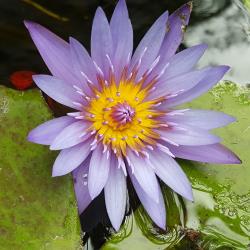- = Hydatellales
Aquatic or sub-aquatic herbs; rhizomatous. Dicotylar; hypogeal germination. Arrangement of floral organs in whorls or irregular. Primary stem with ± scattered vascular bundles; vascular cambium absent; vascular bundles lacking associated sclerenchyma; S-type sieve element-plastids present; aerenchyma present. Stomata anomocytic, hydathodes present. Anthers basifixed, tetrasporangiate and dithecal with longitudinal slits, endothecium present; pollen monocolpate or monoaperturate (Nymphaea), exine tectate-columellate. Carpels 1–many, apocarpic or syncarpic; ovules anatropous (rarely orthotropous), crassinucellate; embryo sac 4-nucleate, maternal perisperm abundant, a diploid few-celled haustorial endosperm. Seeds with thickened exotesta cells, operculate.
The Nymphaeales is an order of three families with about 90 species in eight genera, Barclaya, Brasenia, Euryale, Cabomba, Nuphar, Nymphaea (incl. Ondinea), Trithuria, and Victoria. Although an early angiosperm lineage, most species display morphology in common with other plant groups of aquatic life-style. Cabombaceae and Nymphaeaceae in particular are macrophytes and have prominent specialised air-canals in vegetative parts and floating leaves on long petioles. The Hydatellaceae, however, differ considerably in that they are minute tufts with non-petiolate linear leaves with most species inhabiting ephemeral pools and wetlands. Characters shared (synapomorphies) by the three families include unusual embryological features, such as abundant maternal perisperm, a diploid few-celled haustorial endosperm, and a 4-nucleate embryo sac. Cabombaceae and Hydatellaceae share apocarpy and post-genital carpel closure, and Cabombaceae and Nymphaeaceae share solitary bisexual flowers, an undifferentiated perianth of tepals (Warner et al. 2009) and stellate parenchyma cells with crystals (astrosclereids).
The Nymphaeales are one of the first diverging branches of the flowering plant phylogeny, part of the ANA grade (Amborellales, Nymphaeales, Austrobaileyales). The order of these early lineages, however, is disputed (Borsch et al. 2003; Soltis et al. 2011; Drew et al. 2014; Goremykin et al. 2013, 2015; Gruenstaeudl et al. 2017). The oldest flowering plant fossil is identified as belonging to the Nymphaeales dating to the early Cretaceous, 115–125 Mya (Friis et al. 2001).
| 1 | Plants minute, with simple non-petiolate linear leaves; perianth absent, instead with hyaline bracts | Hydatellaceae |
| Plants not minute, with broad petiolate leaves, simple or divided; perianth petaloid | 2 | |
| 2 | Floating leaves lobed or non-lobed, when lobed sagittate or hastate; perianth with six tepals in two trimerous whorls; gynoecium apocarpic | Cabombaceae |
| Emergent or floating leaves lobed, cordate; perianth with numerous tepals not in two trimerous whorls; gynoecium syncarpic or partially free | Nymphaeaceae |
Almost cosmopolitan, temperate and tropical.
| Category | Number |
|---|---|
| Indigenous (Endemic) | 1 |
| Exotic: Fully Naturalised | 3 |
| Exotic: Casual | 2 |
| Total | 6 |




